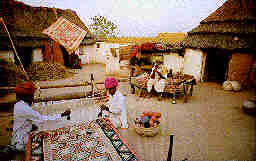
Rural India.
And Rural India is virtually
the cultivator.
|
_____________________
___________________________________________________________________________
India is Essentially Rural India
Time and again we have been told in our text books at schools and colleges, and through speeches by our politicians, economists, etc., that "India is essentially Rural India and Rural India is virtually the Cultivator".
 | India is essentially Rural India. And Rural India is virtually the cultivator. |
Urbanization and Industrialization
In our century the rate of urbanisation is quite rapid as is witnessed in the thousands of people that pour into our major metropolises in search of livelihood, for better employment prospects, better living conditions, etc. But in spite of this urbanisation and industrialisation, India is still overwhelmingly an agricultural country .
Most rural migrants leave their native villages for various negative reasons like famine, floods, loss of land, indebtedness and exploitation . This migration represents on a smaller scale the migration of European peoples to the New World (America), from the 16th century onwards.
Most us have Rural Roots
Though a large majority of educated Indians reside in Urban or semi-urban areas most of us still have some roots in our native villages. Some agricultural land, residential property distant relatives, etc. Event like traditional local festivals, marriages in the family, etc., continue to keep alive the links of most urbanites with their rural roots. But having lived in the cities for most of our lives and in some cases for two or three generations, we have developed an outlook different from that which our rural cousins have. But nevertheless, we come to learn of life of the vast majority of Indians (70% to 75%) who still reside in villages, through text books, mass media, etc.
 | A typical rural couple. |
The Predominance of Rural India is evident during Elections
The relevance of agriculture and the issues before our rural cousins are brought to the fore, time and again by Indian political which keep public attention focussed on the issues facing agriculturists. The vital role of agriculture is also highlighted by the river water disputes between various states, the agitations for minimum procurement prices, support prices, etc. for agricultural produce, agitations for reduction in tariff for power supply, the election promises of some political parties for waiving off of agricultural loans if they come to power keep reminding us of the relevance of the rural populace as vote banks during elections.
The Land Reform legislations of the 1950's and1960's
The Land Reform legislations of the 1950's and1960's have now become things of the past of which we come to know only through our text books. These land reforms abolished the Zamindari land revenue system established by the British. Along with this also went other similar land revenue systems like Ryotwari, Malguzari, Mahalwari, etc. These systems, mainly Zamindari were formalised by the British but they had been in existence since long before British rule came to India. They were in fact a result of thousands of years of evolution of land tenure and which along with the caste system shaped the lives of our forefathers.
As we have seen how caste and casteism are still alive in our minds -whether consciously or sub-consciously in the same manner, though to a lesser extent our agrarian roots are also still living in the minds of an average Indian. How did the institution of landed property come into being is what we shall try to understand in the following paragraphs.
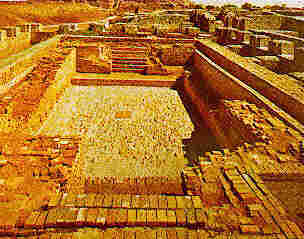 | The Great bath at Mohenjodaro. The Indus valley cities in India's erstwhile Sindh province are one of the oldest urban settlements in the globe. They date back to the 3000 B.C.E. |
The Evolution of Landed Property in Ancient India - References in Vedic Literature
Ownership of Land was Common in Vedic Times
To begin with, as long as human beings roamed in tribal clusters from place to place, land must have naturally been looked upon as a gift of nature and thus the common property of everybody. But when settled agriculture became the main occupation a system would have become necessary for the title to land to be allocated to different individuals. Initially, land was considered to belong to the person who first cleared it. In times of peace, this doctrine to establish the title to landed property would have seemed a logical one. In the transitory stage between nomadic hunting and gathering and the establishment of settled agriculture, there must have existed shifting agriculture. Under the nomadic lifestyle the only items owned by a tribe would have been the weapons used for hunting; and as hunting had to be undertaken collectively even the weapons would have been owned collectively.
In the very next stage of nomadic (shifting) agriculture, the pieces of land that were cleared for cultivation would also have been held under the common ownership of the tribe. Only when settled agriculture became the order of the day would the practice of individual ownership of land could have come into being.
Vedas Prohibited Land Grants
But in an age when in the then recent past all property was under common ownership, the idea of gifting property to any person would have appeared strange.
 | At the dawn of civilization many of our customs, rituals, beliefs, land-holding patterns, etc., were born from the basic necessities and realities of day-to-day life. Their origins are today lost in the misty past and we presume that they have always been a part of our lifestyle. |
The tradition embodied in the Shatapatha Brahmana (a Vedic text) and referred to in the Mahabharata that land must not be given away even on the plea of a sacrificial fee, reflects this attitude. The fact that land grants were being scoffed at indicates that up to the Mahabharata period (dated around 1200 B.C.E.) the idea that land could be an object of purchase and sale had not yet been established. This attitude is in direct contrast to the regular practice of making land grants to Brahmins and noblemen, apart from land becoming an object of regular purchase and sale which was the characteristic of later times.
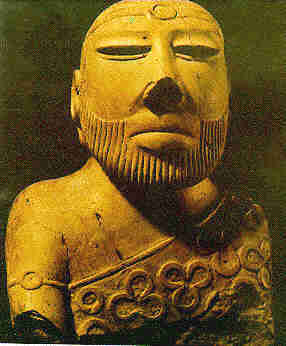 | A replica of a Man from Mohenjodaro dating back to 3000 B.C.E.. (Reproduced from the original sculpture at the National Museum, Delhi). |
Tribal Morality influenced the Prohibition of Land Grants
The above attitude against Land Grants which was seen up to the time of the Mahabharata seems to typify the attitude towards land ownership in Vedic and the Post Vedic times when land was no longer held as common property of the tribe (i.e. the Gana), but in that scenario, individual (private) ownership of land was gradually being established. The fact that land grant also had started is established by the fact that they were frowned at in the legal literature which goes to prove the ambivalent attitude that existed towards a practice that was not prevalent before those days, but had since then begun to be observed.
The Shatapatha Brahmana and the Mahabharata are chronologically placed in the Post-Vedic period but before the rise of the big monarchical states of Koshala and Magadha. In those days the purchase, sale and grants of land was frowned at as land had been till then held till as common property and when individual ownership had finally come to be established it had been linked to the labour put into making it cultivable, as the statement in the Manusmriti (a later text) reflects.
Secondly, in those days of social stratification and the caste system of the later days of Magadhan imperialism (i.e. after 500 B.C.E.) had not yet come about. In the tribal set-up of the days of the Rig Veda (i.e. before 1500 B.C.E.) every male member of a tribe had to work in the collective activity of hunting. When the disintegrating tribal society of hunters, took up agriculture to be its prime occupation, land was collectively owned to begin with. Every member of the tribe seems to have had an equal right to whatever the tribe produced collectively.
Even the tribal chief did not wield the absolute powers that characterised the monarchs of later ages. That the Vedic king's authority was limited is clear from the fact that in the Atharva Veda, Indra is invoked to give the king's share (Bhaga) in the village. But in later times the king himself is stated to be the collector of his share according to the Panchavimsa Brahmana.
 | A bull seal from Mohenjodaro dating back to 3000 B.C.E. Such seals were used as coins in the extensive trade contacts with Babylon. (Reproduced from the original sculpture at the National Museum, Delhi). |
Manusmriti on Rights to Land Ownership
According to an ancient India text, the Manusmriti "Land belong to him who first cleared the timber and a deer to him who first wounded it." This couplet provides a clue to the understanding of a very important doctrine of ancient Indian economics. It makes it clear that, at least to begin with the title to property of land was allied to the labour put into making it cultivable. Finally in a society where the title to property in land was linked to the labour put in to make it cultivable; land grants as well as purchase and sale of land would have seemed strange when there existed vast tracts of freely available virgin land which could be cleared and claimed by any person.
But as the Aryans society established itself on the Gangetic plains, the population gradually increased and the shortage of arable land began to be felt and frequent transfer in the ownership of land became the order of the day. Transfer of land apart from being a sign of settled agriculture also indicates a shortage of land. When virgin land is abundant the motive to transfer land or to get it transferred is naturally weak.
 | A replica of a toy terracotta cart from Mohenjodaro dating back to 3000 B.C.E.. (Reproduced from the original sculpture at the National Museum, Delhi). |
Pattern of Ownership of Land changed from Common to Individual
The changes in the pattern of land ownership also brought about corresponding changes in the connotation of words used in day to day language. In this context it is relevant to note the gradual change in the meaning of the words Bhratru and Bhratrivya. These words occur in the Atharva Veda where they stand for brother and brotherhood. But gradually they came to mean rival and rivalry. This change in connotation shows that hostility had started manifests itself with the Vedic Kulas i.e. families, over the division of property, of which, land was the primary constituent in an agrarian society.
The system of landholding also gradually underwent fundamental changes. Whereas to begin with the whole tribe (Gana) held the ownership of land being cultivated, the ownership gradually narrowed down to the Vamshas or blood relations which further disintegrated to the Kulas or families. This narrowing down of ownership must have affected the size of the individual holdings. Tribal holding upon which the entire tribe used to work, must have been much bigger in size. Its fragmentation into separate family holdings must have naturally limited its size. It must have been further limited in the subsequent period with the rise of the individual proprietary rights on land.
The Ashwa Medha Sacrifice was a Method for Land Grabbing
But after the individual ownership of land had come to be established parallel to the tendency of fragmentation there was also an opposite tendency of the formation of large landed estates.
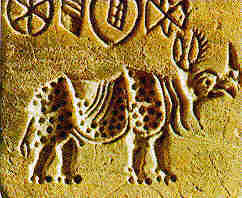 | Another bull seal from Mohenjodaro dating back to 5000 years. |
As people practiced settled agriculture on individually owned land, it could be grabbed by others. The landed estates must have come into being in this way, as a result of war and the grabbing of land of one kingdom by another. The martial caste of the Kshatriyas would have been in the position of carrying out such plunder. The Ashva-Medha Yagna was another method of extending ownership to the lands under weak kings or over lands which had not come under individual proprietary ownership. Such accumulation of land in the hands of a few landlords created a class of landlords and cultivators.
Rise of the Big Monarchical States in the Ganges Valley
With the formation of monarchical states and their capital cities which were the hub of mercantile activities, there emerged a class of absentee landlords who largely lived in the cities but had vast landed properties in rural areas. Such absentee landlords are mentioned in the Pali text of Buddha's time. These absentee landlords had landholdings relatively near the monarchical states of the Ganges valley. These states were mainly Koshala and Magadha. As these landlords came under the sovereignty of the kings of Koshala and Magadha their landholdings came to be integrated with the prospering mercantile economy of these kingdoms. In the Pali texts we find mention of landlord-merchants like Anathapindaka and Kossiyagotta. The state in whose territory these landlord-merchants lived also gained in the form of increasing collection of taxes and the general prosperity.
In these monarchical states, the landlord-merchants played the role of intermediaries between the state and the actual tillers of the soil. Thus a nexus was established between the state and the landed aristocracy. But in the foothills of the Himalayan range which were outside the Gangetic monarchical states of Magadha and Koshala the landed aristocracy was not under the sovereignty of any outside king. The landlords were their own rulers and had conglomorates of oligarchies. Such oligarchies of the Mallas, Lichavvis, Koliyas, etc. are mentioned in the Pali texts.
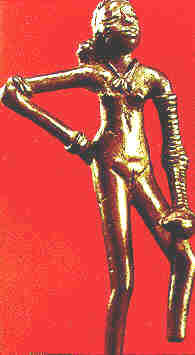 | A bronze dancing girl from Mohenjodaro. Such figurines bear testimony to the development of smelting technology in those days - 5000 years before our times. (Reproduced from the original at the National Museum, Delhi) |
The Struggle Between the Tribal Oligarchies and the Monarchs
These landholding oligarchs were different from the absentee landlords of the plains, in that they were based on their landholdings, did not have any significant mercantile contacts with the outside world and above all did not owe loyalty to any King as did their counterparts in the Gangetic Valley. These landlords were bound to one another in a tribal oligarchy which refused to yield taxes to the monarchies from the Ganges Valley nor did they acknowledge any sort of sovereignty of any outside monarch. Herein lay the seeds of the struggle between the tribal oligarchies and the monarchical states. Right from Ajatashatru who ruled Magadha in the 6th Century B.C.E. during Buddha's time up to the Nandas of the 4th century B.C.E. we hear of a running struggle between the tribal oligarchies of the Himalayan foothills comprising the Mallas, Lichavis, Koliyas and some other tribes with the monarchical states of Koshala and Magadha.
This struggle brought about the destruction of the independent tribal oligarchies. The victory of the monarchies over the tribal oligarchies was also the victory of a more advanced and organised economy over the closed tribal economy. But as a result of this struggle, land the primary factor of production came under state supervision. While the state did not deny the right to private property, it nevertheless adopted measures which siphoned off a large segment of the produce as revenue to be collected in the royal treasury. This further increased the strength of the monarchical states. Thus in the Ganges valley and in the Himalayan foothills, the administrative suzerainty of the Magadhan King came to be absolute . The nexus between the state and the large landholders came to be firmly established. But the regions to the south of the Ganges valley viz., Madhya-desha and Dakshina-patha i.e. Central and Southern India, were still outside the pale of Magadhan imperialism.
 | Since Vedic times hermits and mendicants have been an essential part of Indian society. They started the Guru-shishya parampara (Master-Pupil tradition) of imparting knowledge through ashramas and Gurukulas (monasteries located in forests) The collation of the thoughts of these Masters which have come down to us are known as the Upa-ni-shads (knowledge gained "by being near" - the Master) . |
Fableised recollections of the Aryan Migrations into South India
From the earliest Aryan migrations into the Ganges valley in the Post Vedic period, some Aryan tribes had started trickling down into Central and Southern India. The fableised recollectlon of the Sage Agastya leading the Aryans across the Vindhyas and that of Parshurama retrieving the land of Kerala from the sea so that the Aryans could settle there indicate the migration of the Aryans to Central and Southern India. These immigrants had established pockets of settled agriculture and had mushroomed into small kingdoms. The earlier non-Aryan settlers already had their own kingdoms located in pockets of agriculture, throughout the country. But these kingdoms were relatively small and were separated from each other by dense un-reclaimed forests. Along with this population pressures were being felt in the Ganges Valley by the 4th century B.C.E. This was the general situation when the country's first pan-Indian empire was established by Chadragupta Maurya.
The Raid of Alexander the Great
It was in this scenario where the tribal oligarchies were battling the rising Monarchical States in the Ganges Valley, that Alexander and his Macedonian (Greek) phalanxes crossed the Hindu Kush into Punjab after overcoming the Persian Achameanian Empire. The kingdoms that Alexander faced in Punjab were similar in organisation to the tribal oligarchies of the Hills of Mithila north of Magadha, rather than to the proper monarchies of Magadha and Koshala.
The two main tribal-oligarchical kingdoms in the Punjab were that of Taxila which was ruled by Raja Ambastha (or Ambhi - Omphis in Greek) and Arratta which was ruled by Raja Pururava (or Puru - Porus in Greek). While Ambhi decided that discretion was the better part of valour and made an "honourable" compromise with Alexander by joining forces with the invader against his compatriot Raja Pururava who ruled the land betweem the Vipasha (Beas) and the Vitasta (Jhelum).
 | In 330 B.C.E. Alexander and his Macedonian (Greek) phalanxes crossed the Hindu Kush into Punjab after overcoming the Persian Achameanian Empire. |
Pururava fought a devastating battle with Alexander on the banks of the Jhelum and we are told that the river flew red for a whole day during the battle. Pururava was defeated, but not before he had so demoralised the Macedonian army that it refused to advance forward into India - to the kingdom of the Gangaridans on the Ganges. Alexander retraced his steps after making Pururava his vassal, but the result of Alexander's raid was to destroy the tribal-oligarchical kingdoms in the Punjab which could have posed a hurdle to the growing Mauryan power.
The Rise of Magadha
Meanwhile for three hundred years before the coming of Alexander, Magadha had been growing in importance in the Ganges valley. Magadha and Koshala were two of the most powerful states that had arisen in the Ganges valley in the 6th century B.C.E. i.e. around the time of Gautama Buddha. Koshala was the stronger of the two, and was ruled by King Prasenjit. (If mythology is to be believed Lord Sri Rama ruled Koshala from Ayodhya in earlier times of the epics). The rival kingdom was Magadha and was ruled by Ajatashatru. The two kings were related to one another and so there was no direct war.
But it so happened that during one military campaign, the army of Koshala was camping on a river bed. Unfortunately a flood came about, and the entire army along with its commander Bimbisara (King Prasenjit's son) was washed away. King Prasenjit died of grief soon after this and as there remained neither king nor army to defend the Kingdom of Koshala, it was taken over by Ajatashatru, the king of Magadha.Magadhan power continued to grow till it became the unchallenged power in the Ganges valley.
The Nandas
In around the 4th century B.C.E., the throne of Magadha was usurped by an ambitious general named Mahapadma Nanda. According to the Dharmashastras, Mahapadma Nanda was a Shudra by caste and hence, he is debunked in Dharmashastra literature as an usurper. The Dharmashastras say that, "With the usurping of power by the Shudra Nandas, the Kshatriyas have ceased to exist in Aryavarta." However, the Nandas were powerful, and apparently also just, kings. Mahapadma Nanda's grandson was Dhana Nanda, and he was ruling from Pataliputra when Alexander the Great invaded the Punjab. At that time, Dhana Nanda's kingdom stretched up to the Ganga but did not include today's Western UP and Punjab. Hence, the kingdom of Magadha has been referred to in the Greek chronicles of Alexander as that of the Gangaridans.
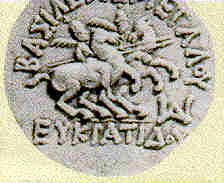 | A Greek Coin from North India. The Greeks left a lasting impression on ancient India. They influenced the Indian ways of thinking, they contributed to Indian sciences and in return they also learnt some new ideas, concepts and philosophies from ancient India. Many later Greek kings patronised Buddhism. Among them was King Menander (Milinda of the Buddhist texts). It is for this reason, that they are known as Indo-Greeks. |
The Greeks, however, never reached Magadha. Among the Greeks who came with Alexander, we are told, there was a rumour that the Gangaridans are far more fierce than the soldiers of Porus (Pururava) whom the Greeks had fought with in Punjab. The Greeks had won a very costly victory against Porus and hence as the Ganagaridans were even more fiercer, the homesick Greek soldiers revolted against Alexander and refused to advance beyond Punjab. Thus Alexander had to retrace his steps from Punjab itself.
The Country's first Pan-Indian Empire
The Maurya empire was established by Chandragupta Maurya soon after Alexander's departure. Chandragupta, guided by his shrewd mentor, Chanakya, overthrew Dhana Nanda, the last Nanda king and crowned himself king of Magadha. He started off the first known political unification of India. His armies conquered virtually the whole of India. The Maurya Empire, under him stretched from Karnataka to Afghanistan and from the river Indus to Bengal. He even attacked the Greek Governor of Punjab, Seleucus Nikator and defeated him. There was subsequently a treaty between Chandragupta and Seleucus whereby, Seleucus ceded Punjab and Sindh to Chandragupta and also gave his daughter in marriage to Chandragupta.
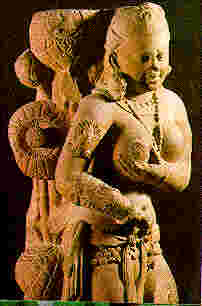 | A Kushana figurine from Mathura. The Kushanas who came from China in the 1st century B.C.E., displaced the Greek rulers from Bactria (Afghanistan) and North India. But they were themselves influenced both by the Greek and Indian cultures. The Kushana figurine here displays both Indian and Greek influences. |
But now we had an empire that stretched all across India. Revenue collection was now to be a qualititively different task than what it had been under the small pre-Mauryan kingdoms of the Ganges valley. What made this task more difficult was the fact that dense forests separated the isolated pockets of settled agriculture and as against the dense forests there existed a surplus population in the Ganges valley. This apart the aboriginal tribes that roamed in the forests practiced shifting agriculture. Thus to bring the vast empire under a dependable revenue collection system, the state had to undertake more fundamental tasks beyond simple revenue collection to ensure proper and systematic collection of revenue.
_________________________________________
Now we move on to examine the change which the first Pan-Indian empire of the Mauryas brought about in the Landholding Patterns and consequently on the Political Set up in ancient India.
_____________________________________________________________
_________________________________________________________________________________
____________________________________
|
|
_ _ _ |
View My Guestbook
|
_______________________________________
_________________________________
